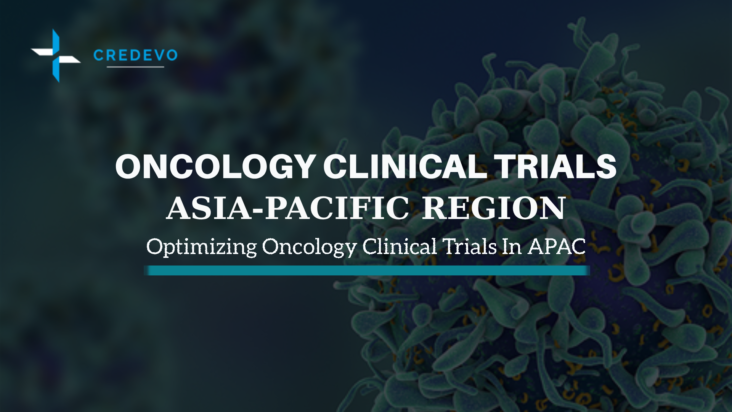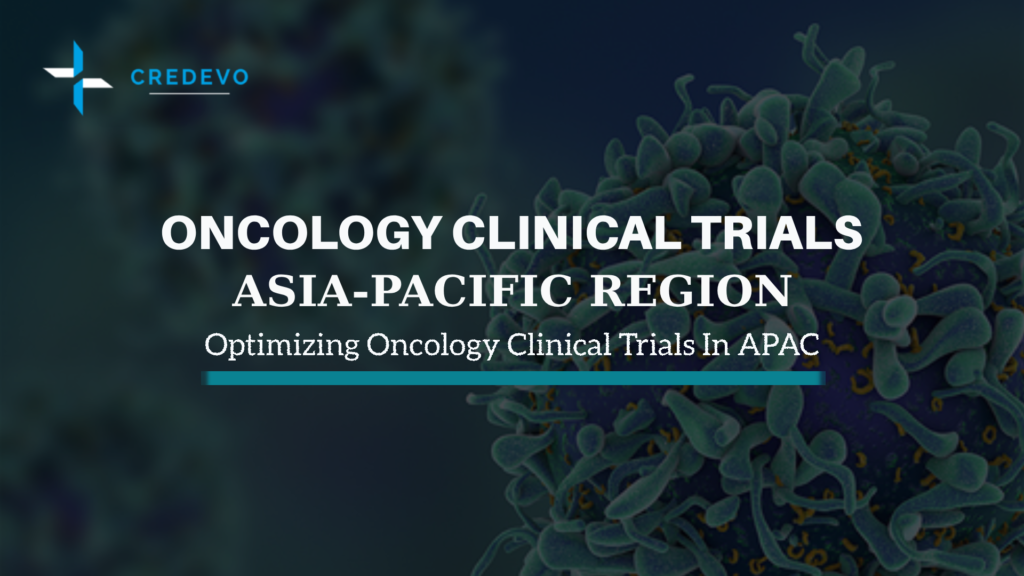Clinical Trials in Oncology: Why ASIA-PAC Stands Out as the Destination of Choice

The APAC region has had a remarkable increase in oncology clinical trial activity, and it is currently leading the world in the overall number of ongoing oncology clinical studies. The Asia-Pacific region has emerged as an epicenter of clinical trial activity, accounting for over half of total global clinical trials. With these growth tendencies projected to continue, the APAC region is predicted to outperform the rest of the world.

The global oncology clinical trials market was valued at USD 12.92 billion in 2022 and is expected to increase at a compound annual growth rate (CAGR) of 5.2% between 2023 and 2030. Asia Pacific is predicted to expand at the fastest rate of 7.1% between 2023 – 2030.
This article explores the favorable conditions for oncology clinical trials in APAC countries, as well as key measures to consider for the success of clinical trials.
Factors driving the rapid expansion of oncology clinical trials in Asia-Pacific
The APAC area has many advantages that make it suitable for conducting high-quality clinical trials at low costs. Factors that need to be considered include regulatory compliance, cost-effectiveness, access to vast patient populations, and the presence of prominent research institutes and investigators.
Let’s discuss each reason in detail to understand the advantages of preferring the APAC region for clinical trials.
1. Rising incidence of cancer in the APAC region.
APAC region has high cancer rates, accounting for over half of all cancer deaths worldwide.
Every year, Asia Pacific accounts for half of all new cancer cases globally, and cancer-related deaths in Asia are expected to rise by 36% by 2030.
In 2022, there were anticipated 20 million new cancer cases and 9.7 million deaths worldwide. China alone accounts for 24.2 percent of new cancer diagnoses and 26.4 percent of cancer deaths globally. [2]
The region’s aging population is a significant factor driving this trend.
The most prevalent cancers in the APAC region are lung, breast, colorectal, liver, and prostate.
In oncology, the Asian population’s pharmacogenomic profile is a crucial component, necessitating the need for Phase I data in local populations. One example is the genetic polymorphism for P450 enzymes, which can cause significant variance in drug PK in various cultures.
The incidence and mortality rates of major cancer types
The following table illustrates the incidence and mortality rates of major cancer types in some countries in the APAC
| Country | Incidence | Mortality | Most commonly diagnosed cancers in APAC |
|---|---|---|---|
| Australia | 212332 | 51884 | Breast cancer; Prostate cancer; Colorectal cancer; Melanoma; Lung cancer |
| Singapore | 25250 | 13277 | Lung cancer; Colorectal cancer; Liver cancer; Breast cancer; Prostate cancer |
| South Korea | 237701 | 97615 | Lung cancer; Colorectal cancer; Stomach cancer; Breast cancer; Thyroid cancer |
| Japan | 1005157 | 426278 | Lung cancer; Colorectal cancer; Stomach cancer; Breast cancer; Pancreatic cancer |
| Malaysia | 51650 | 31633 | Breast cancer; Colorectal cancer; Lung cancer; Ovarian cancer; Prostate cancer |
| Thailand | 183541 | 118829 | Liver cancer; Lung cancer; Breast cancer Colorectal cancer; Prostate cancer |
| New Zealand | 38157 | 11301 | Colorectal cancer; Breast cancer; Prostate cancer; Lung cancer; Melanoma |
| India | 1413316 | 916827 | Breast cancer; Lip and oral cavity cancer; Cervical cancer; Esophageal cancer; Colorectal cancer; Ovarian cancer |
| China | 4824703 | 2574176 | Lung cancer; Colorectal cancer; Thyroid cancer; Stomach cancer; Liver cancer |
2. High patient population & faster enrollment
- APAC is home to 60% of the world’s population, with more than 2.3 billion people living in cities.
- Many APAC countries have similar or higher disease frequency than Western countries, making APAC an appealing location for clinical trials, particularly considering recent patient participant shortages in other regions. Consider this when designing clinical trial strategies for rare cancers and biomarker investigations.
- The metropolitan location of these vast population pools facilitates the speedy recruitment of trial subjects who are mostly treatment-naive patients.
- APAC has a lower trial density compared to other locations due to its larger patient population and lower study volume. This reduces competition for eligible patients, leading to the region’s high recruitment rate.
- This socioeconomic population is often responsible for paying for their healthcare, which could make them more willing to participate in clinical trials.
3. Local innovation
- Global pharmaceutical companies looking to market a medicine in APAC must demonstrate important pharmacokinetic (PK) and pharmacodynamic parameters in an Asian population, specifically Chinese or Japanese populations.
- In recent years, regulatory authorities have shown an increased willingness to accept Phase I data provided in another country with appropriate bridging data (PK and pharmacogenomics).
- APAC countries, including Korea and China, are actively developing novel cancer compounds, with considerable support from the government.
- Immuno-oncology is a rapidly growing field both globally and in APAC. The number of trials underway in China in adoptive cell transfer (ACT), which includes chimeric antigen receptor T-cell therapy (CAR-T), exceeds that in the Western world, however, most of them have been investigator-initiated.
- This is changing, with an increase in studies sponsored by Chinese corporations. All APAC countries have well-established immune checkpoint inhibitor development programs.
- APAC countries, including China, Japan, and South Korea, have established genomic screening initiatives and large-scale platforms to find oncogenic drivers and advance the development of new molecular drugs and diagnostics.
4. Access to world-renowned key opinion leaders and certified clinical trial centers
- The APAC region is proud of world-class key opinion leaders and specialized clinical trial infrastructure.
- APAC’s growing clinical trial activity, both domestic and international, is bringing major CROs and pharmaceutical corporations to its expanding research facilities.
- Numerous trained therapeutic experts in the area have experience in global drug development, research training, and International Good Clinical Practice (IGCP).
- Key opinion leaders are frequently members of international medical and scientific organizations, as well as authors of studies published in prestigious medical journals.
- Many APAC countries have made significant expenditures to enhance clinical trial competitiveness by building cutting-edge medical facilities equipped with modern machinery, technology, and infrastructure.
5. Access to site and quality data
- Compared to Europe and the United States, APAC has a far broader range of site accessibility, particularly for oncology trials.
- Potential bottlenecks in site access across APAC are not attributable to patient access, but rather to the amount of time investigators and research coordinators have available to perform clinical studies, with oncology study sites being particularly busy.
- Previously, sponsors may have had concerns regarding data quality in the APAC area.
- This opinion is changing as more stringent laws and oversight are put into effect. Clinical trial data from Asia Pacific has been accepted for US FDA and EMA submissions.
- For example, Australia has a well-established clinical research sector with considerable oncology experience and highly experienced research teams. Care standards are far more comparable to those in Europe than in other APAC countries.
6. Decentralized trials
- COVID-19 accelerated the use of digital technologies, leading to a surge in pharmaceutical outsourcing to CROs.
- Pandemic-related site closures and travel restrictions led to increased implementation of decentralized trial procedures.
- DCTs provide a patient-centric approach to clinical trial administration, encouraging participants to actively improve their health and contribute to scientific knowledge. DCT can improve enrollment, compliance, retention, and real-time data quality by engaging patients wherever they are.
- APAC countries have a strong understanding of digital health technology, including electronic medical records, electronic data capture (EDC), and telemedicine.
- APAC countries have high rates of mobile phone use, internet availability, and technology acceptance, making them a prime location for DCT research.
Key considerations for study success in APAC countries for oncology trials
The size and significance of the APAC market, as well as the needs of its population, lead sponsors to choose APAC for clinical studies. However, the decision requires a certain level of attention to be totally successful.
- Regulatory Landscape: The regulatory landscape in APAC is continually evolving, therefore sponsors must be prepared to develop a trial design that can be adapted to accommodate any changes. They should also work closely with their local partners to make sure that all regulatory requirements are met. Understanding the regulatory requirements and approval processes for oncology clinical trials in each APAC country is crucial for the success of clinical trials.
- Patient Recruitment: Developing effective strategies for patient recruitment is critical for oncology trials in APAC countries. Transportation challenges exist in many APAC countries, therefore sponsors must carefully plan for all circumstances to limit risk in multicenter studies, such as variable compliance with study procedures across sites. These difficulties may affect not just the transportation of study materials and biospecimens, but also the travel of study participants.
- Cultural and Linguistic Considerations: Language, culture, and belief systems can impact how clinical trials are perceived, study design, and patient outcomes. Successful clinical trials require adapting study protocols to local standards of care and conventions. Translation of trial documentation, particularly patient-facing materials, may be needed.
- Data Quality and Monitoring: Sponsors must implement comprehensive data management systems, quality assurance processes, and monitoring techniques to proactively discover and rectify concerns while using technological advances to evaluate data in real-time more effectively.
- Collaborative Partnerships: APAC has a strong research ecosystem that includes university institutions, research centers, and contract research organizations (CROs) that focus on nutraceuticals. Establishing collaborative partnerships with industry, academia, and government bodies facilitates trials and ensures access to cutting-edge scientific knowledge.
- Local expertise: In APAC countries, having a local partner with contacts with investigators, locations, and key opinion leaders is crucial for successful operations. To address the diverse challenges faced by each country in the APAC area, sponsors may need to work with different CROs.
- Knowledge of the Local Market: Understanding the local market also provides insight into the disparities in market access between countries in the region. The healthcare landscape and market-access environment are complex due to differences in demography, market maturity, cost, and reimbursement systems.
Conclusion
APAC has been a clinical research powerhouse for over two decades and will continue to be the primary focus for global pharmaceutical businesses. Biopharmaceutical companies are moving clinical trials to Asia-Pacific because of issues with patient recruitment and retention, high expenses, and extended deadlines. Considering the APAC region’s advantages in clinical trial execution, sponsors can choose Asia-Pacific countries for cancer clinical trials with low failure rates.
Do you have further inquiries about selecting the ASIA-PAC region for your oncology trials?
Do you have any inquiries or encounter challenges when exploring clinical trial opportunities within the ASIAP-PAC regions? Please provide your details below to connect with our team of experts.